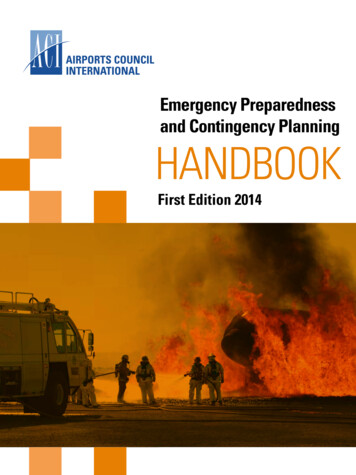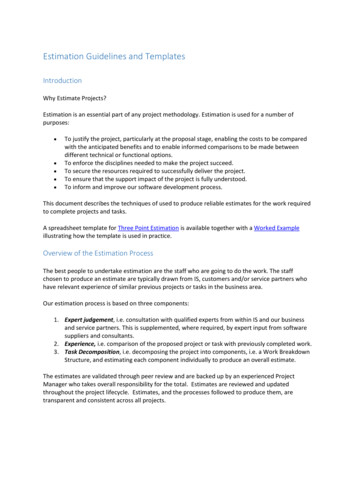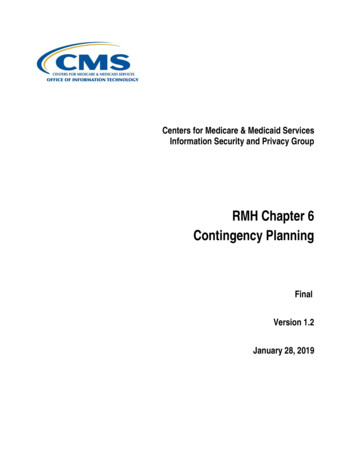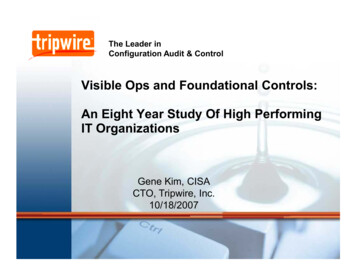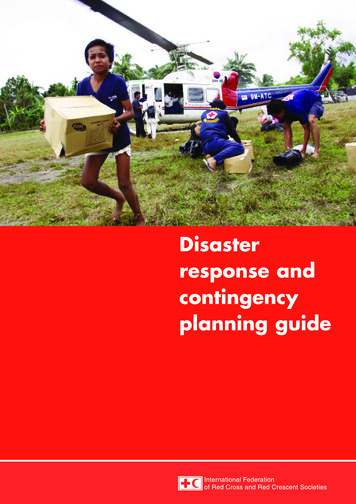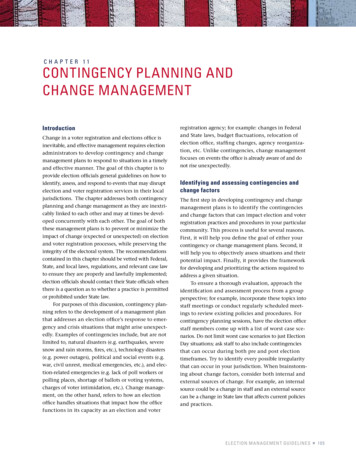
Transcription
C h apte r 1 1CONTINGENCY PLANNING ANDCHANGE MANAGEMENTIntroductionChange in a voter registration and elections office isinevitable, and effective management requires electionadministrators to develop contingency and changemanagement plans to respond to situations in a timelyand effective manner. The goal of this chapter is toregistration agency; for example: changes in Federaland State laws, budget fluctuations, relocation ofelection office, staffing changes, agency reorganization, etc. Unlike contingencies, change managementfocuses on events the office is already aware of and donot rise unexpectedly.provide election officials general guidelines on how toelection and voter registration services in their localIdentifying and assessing contingencies andchange factorsjurisdictions. The chapter addresses both contingencyThe first step in developing contingency and changeplanning and change management as they are inextri-management plans is to identify the contingenciescably linked to each other and may at times be devel-and change factors that can impact election and voteroped concurrently with each other. The goal of bothregistration practices and procedures in your particularthese management plans is to prevent or minimize thecommunity. This process is useful for several reasons.impact of change (expected or unexpected) on electionFirst, it will help you define the goal of either yourand voter registration processes, while preserving thecontingency or change management plans. Second, itintegrity of the electoral system. The recommendationswill help you to objectively assess situations and theircontained in this chapter should be vetted with Federal,potential impact. Finally, it provides the frameworkState, and local laws, regulations, and relevant case lawfor developing and prioritizing the actions required toto ensure they are properly and lawfully implemented;address a given situation.identify, assess, and respond to events that may disruptelection officials should contact their State officials whenTo ensure a thorough evaluation, approach thethere is a question as to whether a practice is permittedidentification and assessment process from a groupor prohibited under State law.perspective; for example, incorporate these topics intoFor purposes of this discussion, contingency plan-staff meetings or conduct regularly scheduled meet-ning refers to the development of a management planings to review existing policies and procedures. Forthat addresses an election office’s response to emer-contingency planning sessions, have the election officegency and crisis situations that might arise unexpect-staff members come up with a list of worst case sce-edly. Examples of contingencies include, but are notnarios. Do not limit worst case scenarios to just Electionlimited to, natural disasters (e.g. earthquakes, severeDay situations; ask staff to also include contingenciessnow and rain storms, fires, etc.), technology disastersthat can occur during both pre and post election(e.g. power outages), political and social events (e.g.timeframes. Try to identify every possible irregularitywar, civil unrest, medical emergencies, etc.), and elec-that can occur in your jurisdiction. When brainstorm-tion-related emergencies (e.g. lack of poll workers oring about change factors, consider both internal andpolling places, shortage of ballots or voting systems,external sources of change. For example, an internalcharges of voter intimidation, etc.). Change manage-source could be a change in staff and an external sourcement, on the other hand, refers to how an electioncan be a change in State law that affects current policiesoffice handles situations that impact how the officeand practices.functions in its capacity as an election and voterElection M anagement Guidelines 10 5
tipCHANGE MANANGEMENT TIP: Do not wait forsituations to come up before you address them. Beproactive and learn to regularly evaluate the needfor change; involve staff, election workers, and otherstakeholders in this process.tipCONTINGENCY PLANNING TIP: Do not wait forsituations to come up before you address them. Beproactive and learn to regularly identify and assesscontingencies; involve staff, election workers, andother stakeholders in this process.Change factor election office is relocatedGoal ensure all office functions continue to operatesmoothly during relocation processOnce you have identified all contingencies andchange factors, proceed with assessing the magnitude of impact these events can have on your officeand the election and voter registration processes.This will help uncover vulnerabilities in the current system and assist in developing contingencyand change management plans that may prevent anevent from occurring or mitigate its impact.To ensure consistency in the assessment process,establish basic criteria for the magnitude of impactfor each contingency or change factor. A basic formatto follow initially would be to use “low impact,”Table 11.1 lists several examples of possible contingencies and change factors; review the list andsee what other examples you can think of for eachcategory. In addition, when you list the contingen-“medium impact,” and “high impact” categories, andfor each of these levels develop an explanation ordefinition of what each one entails. For example: LOW impact of event does not significantly dis-cies and change factors, begin to think of them asrupt the election process; does not require significant“goals.” A goal is the general end result you wouldresources (internal or external); does not require imme-like a contingency or change management plan todiate attention; does not require revision of existing poli-achieve. It conveys the message in general, broadcies or proceduresterms and does not specify strategies or outcomes. MEDIUM requires attention of the election office;This will begin to provide the framework for devel-response needed within a reasonable timeframe; can beoping your contingency and change managementhandled internally or with minimal external resources;plans. For example:may require revision of existing policies or proceduresContingency fire in voting system warehouse one HIGH event causes a state of emergency; requiresweek before Election Dayimmediate attention; threatens the integrity of theGoal prevent fires in voting system warehouse andelection process; significant resources required, bothmitigate impact of fires on warehouse and votinginternal and external; requires revision of existingsystem equipmentpolicies or proceduresTABLE 11.1: EXAMPLES OF CONTINGENCIES AND CHANGE FACTORSContingenciesChange FactorsFire in voting system warehouseElection office is relocatedSevere snow storm (blizzard) on Election DayReduction in number of staff membersElectrical damage to office computers during peak voter registrationweeks prior to electionPurchase of new voting systemPoll workers do not show up at their assigned polling placeNew State law requires poll workers receive 8 hours of training priorto an electionPolling place runs out of provisional ballotsOffice budget is reduced by 7%10 6 U.S. Election Assistance Commission
The above model is generic and meant to serve asevent happening. For example, if earthquakes area source of ideas for how to assess the level of impactlisted as a contingency one would need to evaluatechanges can have in elections. However, using thisthe probability of such an event occurring in one’smodel as an example, one can begin to understandlocal jurisdiction. If the jurisdiction has no historythe level of risk a contingency poses to an electionof earthquakes, then the likelihood of the event isoffice and how a change factor may impact the cur-low and the priority for developing a contingencyrent environment. Most contingencies will fall inplan would rank low as well. However, if the jurisdic-the medium to high categories by their nature, whiletion does have a history of earthquakes then a con-change factors can vary from low to high. In order totingency plan for such an event would be considereddetermine the level of impact, begin by asking ques-a high priority. Determining the likelihood of antions to clarify the situation (Table 11.2) and thenevent is important because it helps agencies prioritizedetermine the level of impact. These will also becomecontingencies and the resources they require.1the building blocks for the action steps you developlater in your contingency plan.Following the example for assessing the magnitude of impact, develop definitions for the likeli-In contingency planning there is an additionalhood of an event occurring. We have used the “low,”step in the assessment process that needs to be taken“medium,” and “high” categories once more to sim-into account – determining the likelihood of anplify the process:TABLE 11.2: ASSESSING MAGNITUDE OF IMPACTContingenciesFactors to ConsiderMagnitude of ImpactFire in voting system warehouseWhat was the extent of the damage? How many voting systems arenot functional as a result of the fire? What backup systems do wehave that can be immediately put on the field?Medium to HighSevere snow storm (blizzard) onElection DayHow accessible are the roads leading to the polling places? Howlong will the severe weather last? Can polling places be relocatedto more accessible locations? Has a state of emergency beendeclared by the State?HighChange FactorsFactors to ConsiderMagnitude of ImpactElection office is relocatedIs the new facility accessible by public transportation? Is the spacesmall, large, or the same in size to the previous location? Whereand how will supplies be stored?Low to MediumReduction in number of staffmembersIs the reduction permanent? How will responsibilities be dividedamong the remaining staff?Low to MediumThe concepts for “magnitude of impact” and “likelihood of event” aremodeled on risk assessment strategies found in the National Instituteof Standards and Technology’s Risk Management Guide for InformationTechnology Systems (special publication 800-30). See Resources sectionat the end of this chapter for full citation.1Election M anagement Guidelines 10 7
LOW likelihood of event occurring is low, threat istipAnother tool you can use during the identificationnegligible; policies and procedures are in place to preventand assessment process to supplement (not replace)the event or mitigate the magnitude of impactthe evaluation, in either contingency or change MEDIUM likelihood of event is likely but uncertain;management planning, is to conduct an analysispolicies and procedures are in place that may preventof the Strengths, Weaknesses, Opportunities, andthe event or mitigate the magnitude of the impactThreats (S.W.O.T. analysis) that can assist or impede HIGH event is highly probable; policies and procedurethe successful development and implementation ofare not in place to prevent the event or mitigate thethe identified change or contingency plan. A samplemagnitude of impactS.W.O.T. analysis worksheet can be found at the endof this chapter.For example:ContingencyLikelihoodFactors to considerMagnitude of impactPolling place runs out ofprovisional ballotsMediumVoter turnout is not predictable;evaluate public interest in contests andissues on the ballots; availability ofbackup provisional ballots; time it takesto deliver new supply of ballots to eachpolling placeMedium to HighIdentifying and assessing the contingencies andchange factors that can or will impact your electionoffice are the initial steps required to develop soundcontingency and change management plans. Theyprovide the foundation for determining the resourcesand plan of actions required to address situations ina timely and effective manner. The following twosections will separately address how to develop andimplement contingency and change managementplans for your election office, and they will addresssome of the ideas already explored in this chapter.1. Set a goalIn the previous section of this chapter, the concept ofdeveloping a goal was briefly mentioned. The following example was given: Contingency fire in voting system warehouse Goals prevent fires in voting system warehouseand mitigate impact of fires on warehouse andvoting system equipmentAs you can see, a goal is the general end resultyou would like a contingency plan to achieve. It conveys the message in general, broad terms and doesDeveloping and implementingcontingency plansThe following five steps describe the general processfor developing and implementing a contingency plan:1. Set a goalnot specify strategies or outcomes. In addition, thegoal of the contingency plan should be in alignmentwith the overall mission and goal(s) of the agency.In other words, the outcome(s) of the contingencyplan help support and achieve the agency’s strategicplan. 2 It is also important to note that agencies may2. Define the purposedevelop a strategic plan for their contingency plan-3. Specify objectivesning program in general, which would include its4. Develop an action planown goal(s) and objectives. If so, contingency-specific5. Implement action planplans would help support and achieve the missionand goal(s) of both the program and the agency’sstrategic plans.10 8 U.S. Election Assistance Commission
Some examples of a contingency planning Purpose of contingency plan establish poli-program’s goals could be:cies and procedures for preventing and mitigating To provide prompt and effective responses to emer-the effects of fire on the voting system warehousegencies and crisis situations while preserving thethrough proper fire safety practices and commu-integrity, transparency, and accessibility of thenity collaborationelection process. The prevention or minimization of any interrup-As you may note in the example above, the purpose focuses the plan on fires that occur only in thetion in the election processes during emergencyvoting system warehouse; fires that occur in otherand crisis situations.places (e.g. other storage facilities, polling places, To ensure rapid and complete recovery of the election processes to normal conditions followingemergencies/disasters. Serve as a model agency in the area of emergencyand crisis recovery.Here is another example of a goal for a contingency-specific plan: Contingency poll workers do not show up at theirassigned polling place Goal ensure polling places are fully staffedthroughout Election Day2. Define the purposeNow that you have set a general goal, define the purpose of the contingency plan. The purpose refers tothe scope (i.e. parameters, authority) of the contingency plan. It gives the plan a specific framework inwhich to operate, giving it focus. For example: Contingency fire in voting system warehouse Goals prevent fires in voting system warehouseand mitigate impact of fires on warehouse andvoting system equipmentelection office, etc) fall outside the scope of this contingency plan. The latter would have to be addressedin a separate contingency plan.3. Specify objectivesObjectives refer to the specific outcomes that supportand help achieve the goal(s) of the contingency plan;these should be clear, measurable, achievable, realistic, and be time-bound.Here are some examples of possible objectives forthe example we have been using regarding fires inthe voting system warehouse: Contingency fire in voting system warehouse Goals prevent fires in voting system warehouseand mitigate impact of fires on warehouse andvoting system equipment Purpose of contingency plan establish policies and procedures for preventing and mitigatingthe effects of fire on the voting system warehousethrough proper fire safety practices and community collaboration Objectives:1. reduce probability of fire occurrence at least 50%by the next scheduled State/local electionStrategic planning refers to the process of comprehensive, integrativeprogram planning that considers, at a minimum, the future of currentdecisions, overall policy, organizational development, and links to operational plans. [Definition from the Center for Program Evaluation, whichis part of the Bureau of Justice Assistance of the U.S. Department ofJustice’s Office of Justice Programs - ].In addition, the U.S. General Accounting Office (GAO) states thatstrategic plans “are intended to be the starting point for each agency’sperformance measurement efforts. Each plan must include a comprehensive mission statement based on the agency’s statutory requirements, a set of outcome-related strategic goals, and a description ofhow the agency intends to achieve these goals. The mission statementbrings the agency into focus. It explains why the agency exists, tellswhat it does, and describes how it does it. The strategic goals thatfollow are an outgrowth of this clearly stated mission. The strategicgoals explain the purposes of the agency’s programs and the resultsthey are intended to achieve.” [GAO. Executive Guide: EffectivelyImplementing the Government Performance and Results Act. June 2. ensure smoke detectors are operational 100% ofthe time3. ensure sprinkler system is operational 100% ofthe time4. mitigate impact of fires on voting systemequipment5. develop fire safety measures in collaborationwith local firemen and police6. have backup voting system in case fire destroysequipment in warehouse7. establish policies and procedures for conductingan election with the backup voting systemElection M anagement Guidelines 10 9
8. train staff and poll workers in both regular andbackup voting systems4. Develop an action planYou have the defined the goal, purpose, and objectives of the contingency plan – now, turn that information into an action plan. The action plan shouldspeak to the goal and objectives you have established;each action step should relate back to a particularobjective(s). The plan should also define the staff,budget, time, training needs, and resources neededto accomplish the tasks and achieve the goal. Not allaction plans will look the same, some will be more7. establish policies and procedures for conductingan election with the backup voting system8. train staff and poll workers in both regular andbackup voting systems Action steps:1. within 15 days of adoption of the contingencyplan, meet with local fire department to assesssafety of warehouse and develop policies andprocedures for preventing and reducing incidents of fire and the damage caused by them(objective #5)2. install smoke detectors in warehouse within 15complex than other according to the needs of the par-days of adoption of the contingency plan (objec-ticular contingency being considered. In addition, iftives #1 and #2)you have not brought in staff and/or outside resources3. schedule and conduct monthly visits to theto participate in the contingency planning processwarehouse to ensure smoke detectors are opera-up to this point this is the time to do so. Establish-tional 100% of the time (objectives #1 and #2)ing community partners is essential to the success ofmany contingency plans. The role of taskforces andcommunity groups is discussed more in depth inDiscussion Box 11.4, “Community Collaborations.”Example: Contingency fire in voting system warehouse Goals prevent fires in voting system warehouse4. schedule and conduct monthly visits to thewarehouse to ensure sprinkler system is operational 100% of the time (objectives #1 and #3)5. monitor smoke detectors and sprinklers once aweek during the last 30 days prior to a scheduled election (objectives #1, #2, and #3)6. within 30 days of adoption of the contingencyand mitigate impact of fires on warehouse andplan, cover voting equipment with nonflam-voting system equipmentmable material during storage at warehouse to Purpose of contingency plan establish poli-reduce impact of fire (objective #4)cies and procedures for preventing and mitigating7. within 30 days of adoption of the contingencythe effects of fire on the voting system warehouseplan, prevent sprinkler water damage by keep-through proper fire safety practices and communitying voting equipment at least 12 inches off thecollaborationwarehouse floor (objective #4) Objectives:1. reduce probability of fire occurrence at least 50%by the next scheduled State/local election2. ensure smoke detectors are operational 100%of the time3. ensure sprinkler system is operational 100%of the time4. mitigate impact of fires on voting systemequipment5. develop fire safety measures in collaborationwith local firemen and police6. have backup voting system in case fire destroysequipment in warehouse110 U.S. Election Assistance Commission8. within 30 days of adoption of the contingencyplan, designate backup facility to store votingsystem equipment in case current facilitybecomes unsafe as result of a fire (objective #5)You may find it useful to display the action stepsin the form of a table to help you visualize the information and present it to others (see Table 11.3).
TABLE 11.3: SAMPLE VISUAL REPRESENTATION OF ACTION STEPSObjective: #2 ensure smoke detectors are operational 100% of the timeAction stepTimelineLaborcategories(Staff)Labor units(staff timefor this task)LaborCostOtherCostsSpecific activitiesconsult withlocal firemento determinethe number andlocation of smokedetectors requiredfor warehousewithin 5 daysof adoption ofplanDirector8 hours 20/hrmileage toand fromwarehousecontact local firemen,conduct site visit towarehouse (identifyquantity, type,and placement),communicate findingsto staff for purchase ofsmoke detectorspurchase smokedetectorswithin 7 daysof adoption ofplanAdministrativeAssistant3 hours 12/hr0purchase smokedetectors perspecifications, inspectand accept purchasedsmoke detectors, storesmoke detectors untilinstallationinstall smokedetectorswithin 15 daysof adoptionof thecontingencyplanDirector4 hours 20/hrmileage toand fromwarehouseprovide smoke detectorsto technicians,provide placementinstructions and othernecessary informationfor installation,inspect and approveinstallation, maintainrecord of installation,train staff responsiblefor monitoring smokedetectorsTechnician(installer)8 hours 50/hr0receive smokedetectors, install smokedetectors, ensure allsmoke detectors areoperational by end ofinstallation2 Office Staffnot to exceed 2hours per visit 14/hrmileage toand fromwarehousewarehouse site visit,perform evaluation ofsmoke detectors, recordand communicateresults of visit, replacenonfunctioning smokedetectorsmonitor smokedetectors andsprinklers once aweek during thelast 30 days priorto a scheduledelectiononce a weekduring the last30 days priorto a scheduledelectioncontinued next page.Election M anagement Guidelines 111
TABLE 11.3 (cont.)Objective: #2 ensure smoke detectors are operational 100% of the timeAction stepTimelineLaborcategories(Staff)Labor units(staff time forthis task)LaborCostOtherCostsSpecific activitiesmonitor smokedetectors andsprinklers once aweek during thelast 30 days priorto a scheduledelectiononce a weekduring the last30 days priorto a scheduledelection2 Office Staffnot to exceed 2hours per visit 14/hrmileage toand fromwarehousewarehouse site visit,perform evaluation ofsmoke detectors, recordand communicateresults of visit, replacenonfunctioning smokedetectorsschedule andconduct monthlyvisits to thewarehouse tomonitor smokedetectors duringother timesmonthly (otherthan the 30days prior toan election)2 Office Staffnot to exceed 2hours per visit 14/hrmileage toand fromwarehousewarehouse site visit,perform evaluation ofsmoke detectors, recordand communicateresults of visit, replacenonfunctioning smokedetectorstipContact your State and local Department of Emergency Preparedness and request copies of existingaction plans and information on available resources. Representatives from local police and fire departments Media and public relations outreach representativesThese plans and resources can provide the template Political party representativesfor developing a specific operational plan as it relates Agencies and groups that conduct voter educationto elections, including pre-election, early voting,Election Day, and post election activities.and registration efforts Representatives from elderly, disabled, and languageminority groups should be included to ensure contingency plans are effectively communicated and imple-Additional things to consider when developing theaction plan:Coordinate a team meeting with other election officials within your own State to work together to developa State disaster/contingency plan for local electionoffices. Include the following team members: Election officials from small, medium and largejurisdictions, including at least one jurisdictionthat manages each type of voting system deployedwithin your Statemented in regards to these groups Legal staff/representatives from the election officesand other legal organizations vested in elections toensure contingency plans are consistent with applicable Federal, State, and local lawsReview your State election code and regulationsto determine how these guidelines and laws willregulate your actions.Example In some States the Secretary of State has State Election Director and staff membersthe authority to declare an Election Day emergency, thus State Emergency Preparedness Director andpermitting your office to implement approved “emergencystaff members112 U.S. Election Assistance Commissionelection procedures”.
Within your county, it is important to understand the chain of authority for local disasters.Contact your local Emergency Management Department to gather information on your countywideprocedures, including powers and responsibilities ofcounty officials, as well as procedures for managingmedia operations.Once your State Plan has been drafted, eachlocal election official should establish and meet witha local task force to include:5. Implement the planNow it is time to implement the action steps that youhave laid out for your contingency plan. A key activityduring the implementation of the plan is to EVALUATE. Once the plan has been implemented, it is important to assess how effective the action plan was andhow it can be improved for the next time. It is usefulto involve the staff and other teams of people involvedin carrying out the steps of the action plan; they willbe able to better tell you how the plan worked in actual County department representativespractice. It is also as important to communicate the Area law enforcement and fire district agenciesresults of this assessment with your team and interested Area school district representatives Area utility staff members, etc.stakeholders; engaging them in the process will helpthem better understand the successes and challengeselection officials face during moments of crisis.The local area task force provides your officeaccess to resources available throughout your jurisdiction in the event of an emergency. With their inputand the assistance of your Emergency ManagementDirector, begin by developing a chain of authority anddecision tree, including a contact list of these individuals, with home and cell telephone numbers.Throughout the development of your plan,consider the following questions: Are there any gaps, overlaps, or other problem areas? Is it detailed enough? Too detailed? Does the Plan reflect lessons learned (from actualdisasters or tests)? Does the Plan reflect changes in the facilities orinternal processes?Organizing Response TeamsA response team is comprised of designated individuals, and can include county management officials,election staff members, area police and fire staff, andspecific polling place supervisors.Example A disaster response team is comparable to avolunteer Fire Department. The volunteer firemen are regular citizens with other jobs. They are trained as firemenand have a central meeting location (fire station), whichcontains all of their equipment. When a fire occurs, thealarm sounds and they leave their regular jobs, go to thecentral meeting location and perform firefighting dutiesuntil the fire is extinguished. Have the types of situations changed? Are names and phone numbers current?The duties of the response team can include: Are disaster supplies stocked and ready for Implement the procedures as detailed in thedistribution?tipIt is also strongly recommended that the Plan beDisaster/Contingency Plan Initiate the phone tree Serve as a liaison between the response team,management, and other employeestested on a regular basis – no less than twice a year. Direct and supervise operationsThis helps all employees to become familiar with the Maintain and distribute disaster supplies, etc.procedures and reduces your risks in the event of anactual disaster.Each type of disaster/contingency plan shouldhave its own unique response team. As an example,a shortage of provisional ballots in one area of thecounty would require the deployment of a preassigned team of runners who are trained to respondto specific polling places with additional ballots.Election M anagement Guidelines 113
DISCUSSION BOX 11.4: COMMUNITY COLLABORATIONSCommunity CollaborationsThe success of a contingency plan does not rely solely on the internal resources the election office has. Manyemergencies and crisis situations will require the election office to reach out to other agencies and groupsin the community for assistance in managing the situation and ensuring interruptions to the election processes are prevented and/or minimized. As such, it is best to involve key stakeholders from the beginning, i.e.during the development phase of the contingency plan. There are many benefits to this, including: They can be a resource of fresh and innovative ideas. They can provide volunteers, materials, and services. They can provide technical expertise in areas outside the scope of the election office’s func
for developing and implementing a contingency plan: 1. Set a goal 2. Define the purpose 3. Specify objectives 4. Develop an action plan 5. Implement action plan 1. Set a goal In the previous section of this chapter, the concept of developing a goal was briefly mentioned. The follow-ing e
